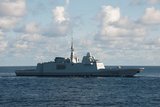Northrop, DARPA set new wireless transmission standard
Northrop Grumman and DARPA have set a new standard for wireless transmission by operating a data link at 100 gigabits per second (Gbps) over a distance of 20km in a city environment.
The two-way data link featuring active pointing and tracking was demonstrated in Los Angeles as part of Northrop Grumman’s Phase 2 contract for DARPA’s 100Gbps (100G) RF Backbone programme.
The 100G system is capable of rate adaptation on a frame by frame basis from nine Gbps to 102Gbps to maximise data rate throughout dynamic channel variations. A 100G data link could transmit high-rate data directly from the aircraft to commanders on the ground in near real time, allowing them to respond more quickly to dynamic operations.
Extensive link characterisation demonstrated short-term error-free performance from nine to 91 Gbps and a maximum data rate of 102Gbps with one erroneous bit received per ten thousand bits transmitted.
The link operates at millimeter wave frequencies - 71-76 gigahertz and 81-86 gigahertz - with five gigahertz of bandwidth or data carrying capacity and uses a bandwidth efficient signal modulation technique to transmit 25Gbps data streams on each five gigahertz channel.
To double the rate within the fixed bandwidth, the data link transmits dual orthogonally polarised signals from each antenna. Additionally, the link transmits from two antennas simultaneously (spatial multiplexing) and uses multiple-input-multiple-output signal processing techniques to separate the signals at two receiving antennas.
The flight test phase of the 100G RF Backbone programme will now demonstrate the 100G air-to-ground link up to 100Gbps over a 100km range and extended ranges with lower data rates.
More from Digital Battlespace
-
![Babcock nears first customer for Nomad AI translation tool]()
Babcock nears first customer for Nomad AI translation tool
Nomad can provide militaries with real-time intelligence, saving critical time on the battlefield.
-
![AUSA 2025: Israel’s Asio Technologies to supply hundreds of improved Taurus tactical systems]()
AUSA 2025: Israel’s Asio Technologies to supply hundreds of improved Taurus tactical systems
Taurus operates alongside the Israel Defense Forces’ Orion system which supports mission management across tens of thousands of manoeuvring forces, from squad leaders to battalion commanders.
-
![AUSA 2025: Kopin pushes micro-LED plans as China moves faster]()
AUSA 2025: Kopin pushes micro-LED plans as China moves faster
The plan for the new displays follows fresh investment in Kopin’s European facilities by Theon and an order for head-up displays in fielded aircraft, with funding from the US Department of Defense.
-
![AUSA 2025: Persistent Systems to complete its largest order by year’s end]()
AUSA 2025: Persistent Systems to complete its largest order by year’s end
Persistent Systems received its largest ever single order for its MPU5 devices and other systems earlier this month and has already delivered the 50 units to the US Army’s 4th Infantry Division.
-
![Aselsan brings in dozens of companies and systems under the Steel Dome umbrella]()
Aselsan brings in dozens of companies and systems under the Steel Dome umbrella
Turkey has joined the family of countries attempting to establish a multilayered air defence system with government approval in August 2024 for the effort landed by Aselsan. Dubbed Steel Dome, the programme joins Israel’s Iron Dome, the US Golden Dome, India’s Mission Sudarshan Chakra and South Korea’s low-altitude missile defence system.
-
![DSEI 2025: MARSS unveils new agnostic multidomain C4 system]()
DSEI 2025: MARSS unveils new agnostic multidomain C4 system
MARSS’ NiDAR system has been deployed using sensors from static platforms to provide detection and protection for static sights, such as critical infrastructure, ports and military bases.



























